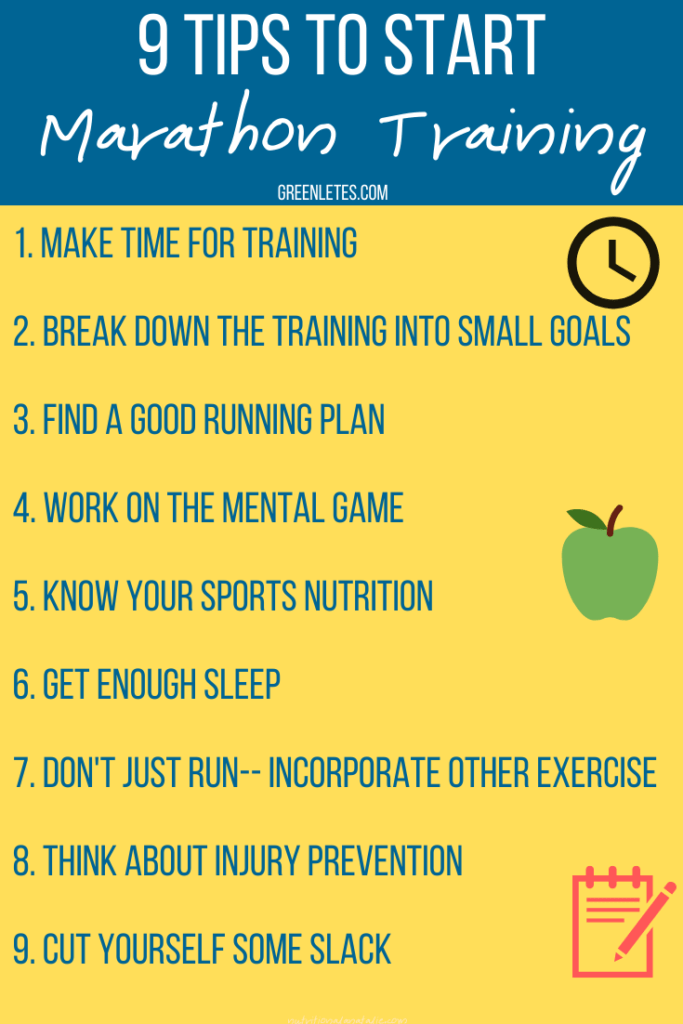Last updated on July 8th, 2021 at 10:07 am
Running your first marathon? These 9 tips will help you conquer the training, understand the nutrition, remain injury free and soar through 26.2!
Taking on your first marathon training induces a whole list of emotions–exhilaration, anxiety, excitement, nervousness, happiness–to name a few. But if you’ve found this post, you’re taking the first step to elevate the positive emotions and banish the negative ones.
As a Type A individual, I tackled my first marathon training like everything else in my life–with a carefully laid out plan. Is this a step-by-step guide to conquering 26.2 miles with ease and being able to go dance afterwards? No. (If you figure out how to do that, write a book on it and make millions!)
But these 9 tips will help you manage the overwhelming feeling that comes along with starting anything as big as running a marathon. So take a deep breath, tell yourself “I got this” and read on.

1. Make time for the training
Most marathon training plans suggest running anywhere from 30-45 miles per week. Over the course of 4 to 5 days, that’s an average of at least 6+ miles each day. In other words, most of your runs will be at least an hour long, and some are even longer. I don’t throw out these stats to scare you, but to let you know that marathon training becomes a HUGE part of your waking hours.
You need to know this going in so that you can make the time for training. If you have to be at work at 7am everyday, it’s probably not realistic to schedule long runs before work. Figure out what will work for you, but embrace the increase in mileage as a positive thing and a time to get outside, listen to music or a podcast or spend time with a running buddy.
2. Break down the training into shorter goals
Starting marathon training with the goal of running 26.2 is overwhelming. Instead, break down your training into mini goals. For example, maybe the first month is to increase your mileage to a half marathon. The second month is to get to high double digits, and the third month is to conquer 20+ miles.
This type of goal setting makes the training more achievable and less daunting. Plus, you will have small victories to celebrate along the way. Remember that marathon training isn’t all about race day!
3. Download a good running plan
For a marathon, it’s pretty impossible to just wing the training. I HIGHLY suggest downloading a plan and sticking to it as closely as possible.
There are a ton of paid programs, like NYRR Virtual Trainer or Training Peaks, or you can download a free program. For my first marathon, I used the Hal Higdon’s Novice 1 program. It really helped keep me on track!
4. Work on the mental game
I wish I could say running a marathon is all physical fitness and nutrition, but a large part of conquering 26.2 is your mental strength. I’ve got 8 tips for building that type of strength in this blog post, so head over there and give it a read for a more in-depth info. But just know that positive affirmations work wonders when marathon training. Talk to yourself and tell yourself what a beast you are!
5. Know your sports nutrition
Obviously I think nutrition is one of the biggest parts of marathon training. Without eating the right things, you are likely to suffer from low energy and/or stomach problems. Luckily, I’ve got you covered with some helpful info, such as:
- The No-Brainer Nutrition Guide For Every Runner has sections on pre-workout, during workout and post-workout fuel, hydration, training for different distances and carb loading.
- Tips for ½ marathon nutrition, which is pretty similar to full marathon nutrition.
- How to avoid marathon training weight gain, which happens to a lot of runners!
- And if you’ve got tummy troubles, I’ve got solutions.
6. Get enough sleep
Has this ever happened to you? You stay up too late watching Netflix, wake up exhausted, skip your morning run, say you’ll do it later and then never do it? Well, it’s happened to me.

Not only is sleep important to get you out the door for the run, it’s necessary to help your muscles recover from the tough training. And it’s vital for following good nutrition. Because when you don’t sleep enough, you’re more likely to just give in and order a pizza for dinner instead of eating that healthy meal you prepped two days ago.
Embrace sleep. Get in bed early and read, and enjoy it. I love my pillow, my comforter and my bed, and I look forward to getting in it. Everything else can wait!
7. Don’t just run!
It’s taken me years of running to realize that running less may actually help make me stronger. Now that’s not to say you should run 10 miles per week and then run a marathon. But it means you absolutely should make time to incorporate strength training, cross training, flexibility exercises and foam rolling into your routine.
If you don’t have the time, why not cut half a mile off your run and spend that time working on these types of exercises? In the long run, it will pay off for injury prevention!
8. Take preventative measures.
Hopefully you’re already working toward preventing injury with all the things I suggested in #7, but there are a few more things to incorporate to help you stay healthy and strong. And these things feel great and can be done while watching TV- score! Ice, heat and rest are just as important as everything else.
For aching joints, ice helps reduce inflammation. After a long run, spend 10 minutes with ice on both knees to ease the pain. For sore or tight muscles, a heating pad will soothe the tension. And resting at least one day per week is so incredibly critical to your training. Your muscles need time to recover during the rest period. Give them that time and enjoy it.
9. Cut yourself some slack
I think this may be the most important point. Although training and nutrition are critical, you must remember that you aren’t perfect. If you skip a day of training or eat something you shouldn’t, cut yourself some slack. There’s always tomorrow to get it right. As long as you stick to your training the majority of the time, you will do great!


0 Comments